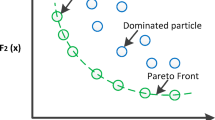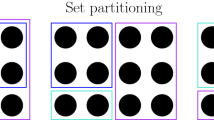Abstract
The price of electrical energy in Spain has not been regulated by the government since 1998, but determined by the supply from the generators in a competitive market, the so-called “electrical pool”. A genetic method for analyzing data from this new market is presented in this paper. The eventual objective is to determine the individual supply curves of the competitive agents. Adopting the point of view of the game theory, different genetic algorithm configurations using coevolutionary and non-coevolutionary strategies combined with scalar and multi-objective fitness are compared. The results obtained are the first step toward solving the induction of the optimal individual strategies into the Spanish electrical market from data in terms of perfect oligopolistic behavior.
Similar content being viewed by others
References
Ministerio de Industria y Energía, “Protocolo para el establecimiento de una nueva regulacíon del sistema elíctrico nacional,” Technical report, Ministerio de Industria y Energía, 1996.
J. Arifovic, “Genetic algorithm learning and the cobweb model,” Journal of Economic Dynamics and Control, vol. 18, pp. 3–28, 1994.
T.C. Price, “Using co-evolutionary programming to simulate strategic behaviour in markets,” Journal of Evolutionary Economics, vol. 7, pp. 219–234, 1997.
R. Franke, “Coevolution and stable adjustments in the cobweb model,” Journal of Evolutionary Economics, vol. 8, pp. 383–406, 1998.
H. Dawid, Adaptative Learning by Genetic Algorithms, Springer-Verlag: Berlin, 1999.
W.W. Leontief, “VerzÖgerte angebotsanpassung und partielles gleinchgewicht,” Zeitschrift fÜr NationalÖkonomie, vol. 5, pp. 670–676, 1934.
R.E. Marks, “Breeding hybrid strategies: Optimal behaviour for oligopolists,” Journal of Evolutionary Economics, vol. 2, pp. 17–38, 1992.
R.E. Marks and L.G. Cooper, “The complexity of competitive marketing strategies,” Complexity International, vol. 6, 1999.
W.D. Hillis, “Co-evolving parasites improve simulated evolution as an optimization technique,” Artificial Life II, pp. 41–47, 1991.
M.A. Potterm, K.A. De Jong, and J.J. Grefenstette, “A coevolutionary approach to learning sequential decision rules,” in Proceedings of the Sixth International Conference on Genetic Algorithms, edited by Larry Eshelman, Morgan Kaufmann: San Francisco, CA, 1995, pp. 366–372.
J. Paredis, “Coevolutionary computation,” Artificial Life, vol. 2, no. 4, pp. 355–375, 1995.
C.D. Rosin and R.K. Belew, “New methods for competitive coevolution,” Evolutionary Computation, vol. 5, no. 1, pp. 1–29, 1997.
W.M. Spears and K.A. De Jong, “On the virtues of parameterized uniform crossover,” in Proceedings of the Fourth International Conference on Genetic Algorithms, edited by R. Belew and L. Booker, Morgan Kaufman: San Mateo, CA, 1991, pp. 230–236.
G. Syswerda, “Uniform crossover in genetic algorithms,” in Proceedings of the Third International Conference on Genetic Algorithms, edited by R. Belew and L. Booker, Morgan Kaufman: San Mateo, CA, 1989, pp. 2–9.
Y.J. Lai and C.L. Hwang, Fuzzy Multiple Objective Decision-Making: Methods and Applications, Springer-Verlag: NewYork, 1996.
D.A. Veldhuizen and G.B. Lamont, “Multiobjective evolutionary algorithms: Analyzing the state-of-the-art,” Evolutionary Computation, vol. 8, no. 2, pp. 125–147, 2000.
C.M. Fonseca and P.J. Fleming, “An overview of evolutionary algorithms in multiobjective optimization,” Evolutionary Computation, vol. 3, no. 1, pp. 1–16, 1995.
C.M. Fonseca and P.J. Fleming, “Multiobjective optimization and multiple constraint handling with evolutionary algorithms-Part II: A application example,” IEEE Transactions on Systems, Man, and Cybernetics, Part A: Systems and Humans, vol. 28, no. 1, pp. 38–47, 1998.
J. Horn, N. Nafpliotis, and D.E. Goldberg, “A Niched Pareto genetic algorithm for multiobjective optimization,” in Proceedings of the First IEEE Conference on Evolutionary Computation, IEEEWorld Congress on Computational Intelligence, IEEE Service Center: Piscataway, NJ, vol. 1, 1994, pp. 82–87.
A. Cournot, Recherches sur les Principies Math´ematiques de la Th´eorie des Richesses, Hachette, Paris, 1838.
Rights and permissions
About this article
Cite this article
de la Cal Marín, E.A., Ramos, L.S. Supply Estimation Using Coevolutionary Genetic Algorithms in the Spanish Electrical Market. Applied Intelligence 21, 7–24 (2004). https://doi.org/10.1023/B:APIN.0000027764.76082.00
Issue Date:
DOI: https://doi.org/10.1023/B:APIN.0000027764.76082.00




